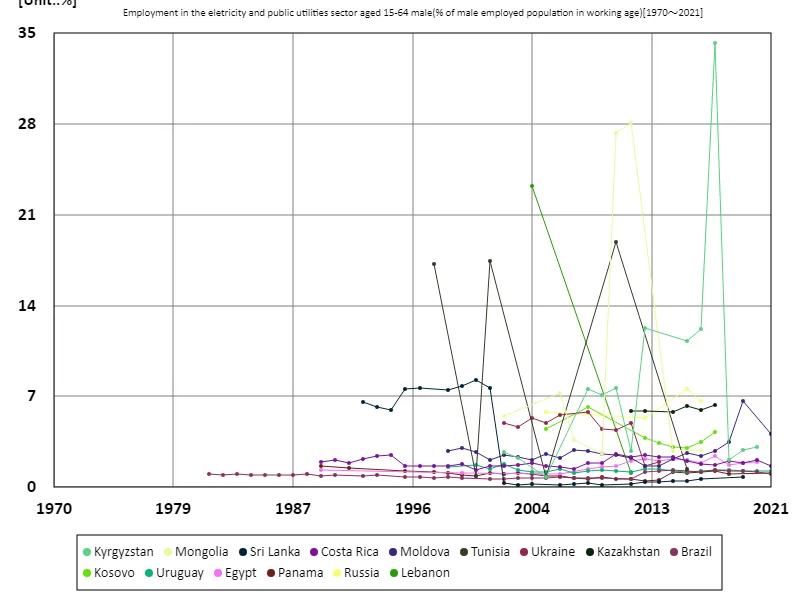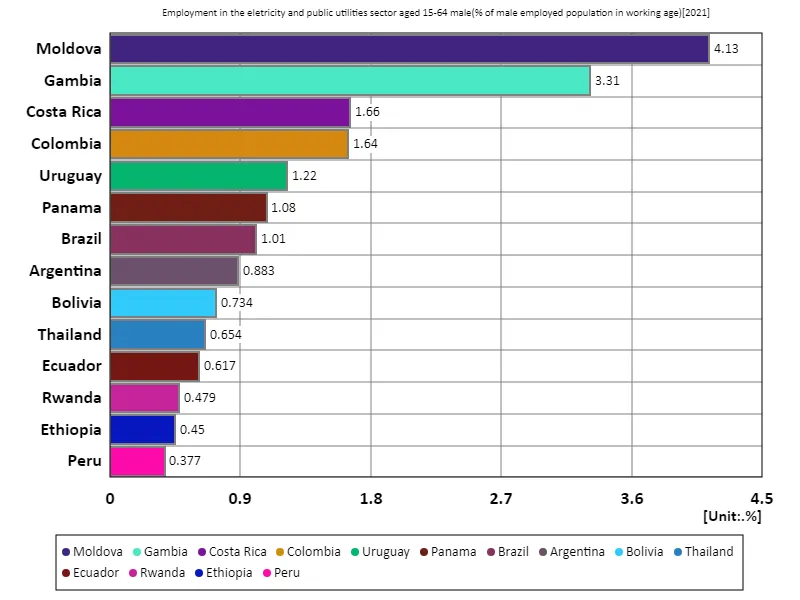- Abstract
- Employment rate for men aged 15-64 in the electrical utilities sector (percentage of working-age males in the workforce)
- Employment rate in the electrical utilities sector for men aged 15-64 (percentage of working-age males in the workforce) (Worldwide)
- Employment rate in the electricity utilities sector for men aged 15-64 (percentage of working-age males in the workforce) (Worldwide, latest year)
- Reference
Abstract
Data on employment rates shows that the employment rate in the electrical utilities sector for men aged 15-64 years is high in Moldova, at 4.13% in 2021. This indicates that employment in this sector is relatively high. Historically, developing and emerging countries have tended to have more public employment, with the public sector sometimes being the primary provider of jobs, particularly in less economically developed regions. Countries like Moldova that rely heavily on public works projects are particularly vulnerable to the effects of government economic policies and infrastructure development. This also tends to lead to a closer correlation between economic stability and labor market trends.
Employment rate for men aged 15-64 in the electrical utilities sector (percentage of working-age males in the workforce)
Looking at data from 1981 to 2021, the employment rate for men aged 15-64 in the electric utility industry has shown significant variation. Kyrgyzstan in particular recorded an outstanding figure of 34.2% in 2017, but has since declined sharply and is currently at 8.98%. This fluctuation reflects changing employment opportunities in the public sector as well as the impact of economic policies. A high employment rate usually indicates an important public sector and labour market instability, with government stimulus packages and infrastructure projects often being the main source of employment. In the case of Kyrgyzstan, the employment rate has fallen sharply from its high peak, indicating a reduction in public works and an expansion of the private sector, likely influenced by changes in the economic structure and the international economic environment.


The maximum is 34.2%[2017] of Kyrgyzstan, and the current value is about 8.98%
Employment rate in the electrical utilities sector for men aged 15-64 (percentage of working-age males in the workforce) (Worldwide)
Based on data from 1981 to 2021, employment rates in electric utilities for men ages 15-64 have fluctuated significantly over time. Notably, Kyrgyzstan recorded an extremely high employment rate of 34.2% in 2017, but has since seen a steep decline, currently standing at 8.98%. This shift reflects the changing role of the public works sector and its economic impact. Kyrgyzstan’s high employment rate at its peak indicates the importance of the public works sector at that time and that it was a major source of employment. However, the recent decline is likely due to cuts in public works, growth in the private sector, and changes in economic policy. In particular, improvements in the efficiency of public works and privatization, as well as changes in the international economic environment, may have contributed to the decline in employment. This shows that public sector employment fluctuates with changes in the economy.


The maximum is 34.2%[2017] of Kyrgyzstan, and the current value is about 8.98%
Employment rate in the electricity utilities sector for men aged 15-64 (percentage of working-age males in the workforce) (Worldwide, latest year)
Based on 2021 data, the employment rate in electrical utilities for men aged 15-64 years was an overall average of 1.3%, reaching a maximum of 4.13% in Moldova. This data shows how important the electric utility industry is to the male labor market. Moldova’s figure of 4.13% suggests that the electrical utility plays a relatively important role in the country’s labour market. However, the relatively low overall average of 1.3% indicates that in many countries electric utilities make up a small proportion of the labour market. This trend reflects the fact that the importance of public works varies widely from country to country. Countries with low employment rates in electric utilities may be experiencing economic diversification and private sector expansion. Public works are small in scale and economic models driven by the private sector are the norm. Conversely, in countries where public works play a major role, infrastructure development and public services are highly important, and it is believed that government economic policies have a significant impact on the labor market. Overall, employment rates in the electric utilities sector are characterised by significant variation depending on economic structure and policies, as well as the country’s stage of development.


The maximum is 4.13% of Moldova, the average is 1.3%, and the total is 18.2%



Comments